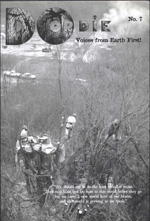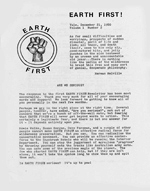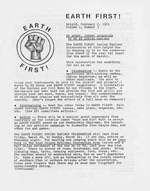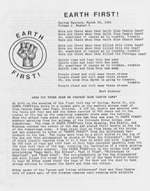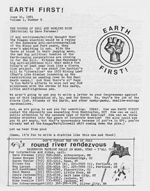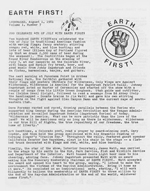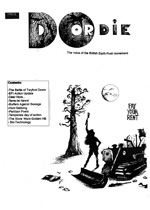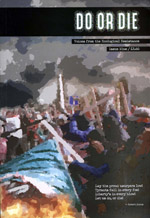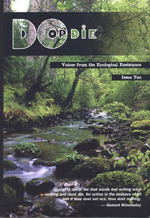The Archives
-
Earth First! Journal, Periodicals
Earth First! Journal 1980-1981
07.17.14 | PermalinkEarth First! Journal Volume 1, Issue #1-8 (1980-1981)
“Like Pallas Athena springing fully armed from the brow of Zeus, EARTH FIRST enters the wilderness fray…”
Earth First Journal. Vol.1 #1.
For all of its many flaws, I love Earth First! and most of the many projects that it has inspired, and I say that as someone fully aware of all the mistakes that have been made along the way. Those errors- everything from alliances with open racists like Ed Abbey to articles cheerleading famine in Africa- are ultimately what makes the history of Earth First! such a valuable roadmap for modern revolutionaries. Earth First!’s fuck-ups are at times so glaring that my hope is, after examining them, there is no way they could be made again.But every analysis of EF! these days talks about the mistakes- so much so that we miss the things that they got right: a structure that rejected hierarchy and encouraged horizontal organizing, a critique of civilization and industrialism that still left room for broad participation from more conservative and liberal elements, and a shockingly warm pluralism that encouraged a love for all kinds of “wilderfreaks” including the vegetarians and “witches” that Foreman so famously dislikes. For all of the machismo in those early years, I was surprised to see hints of eco-feminism creeping into these issues, including a giant pull-quote from Woman and Nature by Susan Griffin. Words from figures like Russel Means abound, and for every cringe inducing moment in these pages I think you’ll also find plenty to make you smile. I mean, how cool is it that the return address on issue #1 is Dave Foreman’s house, or that requests for new volunteers ran alongside Susan Morgan’s home phone number? This was as grassroots as it gets, yet somehow the movement spread across oceans and artificial borders, and to this day people are shouting “No Compromise In Defense of Mother Earth!” Understanding how that happened might be the key to expanding our current efforts.
TALON will be posting every single issue of the Earth First! Journal over the next few years. This project isn’t cheap or easy! If you would like to make a donation of either time, back issues, or money, please contact us HERE. Also, don’t forget that this important publication is still running and needs your support! Subscribe HERE!
…
-
Do or Die, Most Popular, Periodicals
Do or Die – The Complete Set!
04.09.14 | PermalinkDo Or Die #1-10 (1993-2003, Brighton, England.)
A few years ago a friend asked me if I had a complete set of Do or Die, the British Earth First! publication that inspired and incited eco-warriors throughout the 1990s and early 2000s. At one time I did have them, but they had long since been stolen by a Joint Terrorism Task Force.
After a brief discussion, we decided that Do or Die was too important to fade into obscurity. We began tracking down each issue, and decided that while we were at it we ought to archive some other publications as well. That effort is how this web site began, and now, thanks to 56a infoshop of South London and Tim @ NEDS Northampton, we can finally share the very rare issue #2. This completes our collection, and our original mission as well.
When read as a set, Do or Die is a chronicle of people from across the globe counter-striking capitalism, ecocide, and the state. Each issue is better than the last, but more importantly, each page is a spark licking at the fuse of the bomb that is your heart. Once lit, you’ll know that these pages are not mere history, but a reminder that we can explode onto the world stage like the fighters before us have. Do or die, now is the time to rise.
…
-
Do or Die, Periodicals
Do or Die #7
01.30.12 | PermalinkDo or Die #7 (1998, Brighton, England.)
The genesis of Conflict Gypsy came from our founder’s desire to collect and preserve a complete set of Do or Die, the classic British Earth First! publication. While we still have not found copies of issues 1-4, our posting of these book sized epics continues with issue #7.
Do or Die was always reasonably free of the acritical cheer leading of it’s many American counterparts, and this issue manages an honest examination of the limitations and capabilities of direct action campaigns from Poland to Brazil to Mexico. As always, there is a bittersweet mixture of inspiration and despair while reading about the clashes between the oppressed and the powers of the state and industry, but there are enough victories contained in this volume that elation prevails! You will cheer as the black bloc escapes arrests in Derbyshire by switching into hippie clothing and shouting “no violence” as the police roll in (An activist in England nearly pissed themselves telling me that story one night!) and as wild boars recruit domesticated pigs for non-human resistance to domestication. The power of villagers in India to stop dams lessens the pain of reading about the paramilitary massacres of people in Acteal, and other articles will have you thinking deeply about our movements DIY media efforts, prison support, and coalitions with labor groups. All in all, another must read from one of the most exciting periods of resistance in the 20th century.
